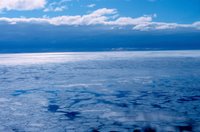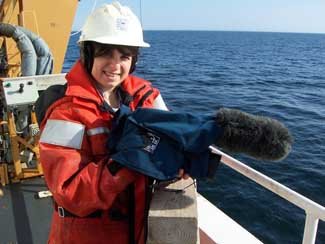Much Ado about Sea Ice
Scientists Jackie Grebmeier and Lee Cooper have been studying the effects of climate change in the Bering Sea for several years. I’ll be joining them on the Healy next Tuesday to gather information about their research for an upcoming “Breakthroughs” exhibition at Liberty Science Center in Jersey City, NJ.
Lee told me in an e-mail that there’s a lot of science in action on the Healy. The research team is gathering data to compare against information they collected over the past few years. In March, Jackie, Lee and colleagues published an article in Science that described major shifts in the northern Bering Sea environment. They reported that rising air and ocean temperatures cause sea ice to melt earlier than normal. Melting sea ice has a far-reaching ripple effect, from bottom-dwelling animals to Walruses to native hunters. What's more, the Bering Sea is the main conduit for nutrients flowing north to the Arctic, and it supports the largest fishery in the US. (Photo credit: Michael Van Woert, NOAA NESDIS, ORA)
is gathering data to compare against information they collected over the past few years. In March, Jackie, Lee and colleagues published an article in Science that described major shifts in the northern Bering Sea environment. They reported that rising air and ocean temperatures cause sea ice to melt earlier than normal. Melting sea ice has a far-reaching ripple effect, from bottom-dwelling animals to Walruses to native hunters. What's more, the Bering Sea is the main conduit for nutrients flowing north to the Arctic, and it supports the largest fishery in the US. (Photo credit: Michael Van Woert, NOAA NESDIS, ORA)
Jackie, Lee and their research team are gathering water samples to measure temperature, salinity and chlorophyll—the chemical that plants use to convert sunlight to energy. Using nets, they collect tiny animals called zooplankton that float in the water. These critters, along with algae and other plankton, form the foundation of the Arctic food web. Mud and sediment from the seafloor can divulge much about the nutrients in the water, dating back many thousands of years. Trawling the sediment reveals what’s for dinner for the birds, walruses and seals that dive for food. Finally, team members board Healy’s helicopter to get their eyes in the sky to survey marine mammals and seabirds.
 Here's a view of sea ice off the starboard bow taken by the Healy webcam. Well, I don’t want to give away all of the details yet. Stay tuned ….
Here's a view of sea ice off the starboard bow taken by the Healy webcam. Well, I don’t want to give away all of the details yet. Stay tuned ….
Lee told me in an e-mail that there’s a lot of science in action on the Healy. The research team
 is gathering data to compare against information they collected over the past few years. In March, Jackie, Lee and colleagues published an article in Science that described major shifts in the northern Bering Sea environment. They reported that rising air and ocean temperatures cause sea ice to melt earlier than normal. Melting sea ice has a far-reaching ripple effect, from bottom-dwelling animals to Walruses to native hunters. What's more, the Bering Sea is the main conduit for nutrients flowing north to the Arctic, and it supports the largest fishery in the US. (Photo credit: Michael Van Woert, NOAA NESDIS, ORA)
is gathering data to compare against information they collected over the past few years. In March, Jackie, Lee and colleagues published an article in Science that described major shifts in the northern Bering Sea environment. They reported that rising air and ocean temperatures cause sea ice to melt earlier than normal. Melting sea ice has a far-reaching ripple effect, from bottom-dwelling animals to Walruses to native hunters. What's more, the Bering Sea is the main conduit for nutrients flowing north to the Arctic, and it supports the largest fishery in the US. (Photo credit: Michael Van Woert, NOAA NESDIS, ORA)Jackie, Lee and their research team are gathering water samples to measure temperature, salinity and chlorophyll—the chemical that plants use to convert sunlight to energy. Using nets, they collect tiny animals called zooplankton that float in the water. These critters, along with algae and other plankton, form the foundation of the Arctic food web. Mud and sediment from the seafloor can divulge much about the nutrients in the water, dating back many thousands of years. Trawling the sediment reveals what’s for dinner for the birds, walruses and seals that dive for food. Finally, team members board Healy’s helicopter to get their eyes in the sky to survey marine mammals and seabirds.
 Here's a view of sea ice off the starboard bow taken by the Healy webcam. Well, I don’t want to give away all of the details yet. Stay tuned ….
Here's a view of sea ice off the starboard bow taken by the Healy webcam. Well, I don’t want to give away all of the details yet. Stay tuned ….


1 Comments:
Bon voyage! Bon chance!
Post a Comment
<< Home